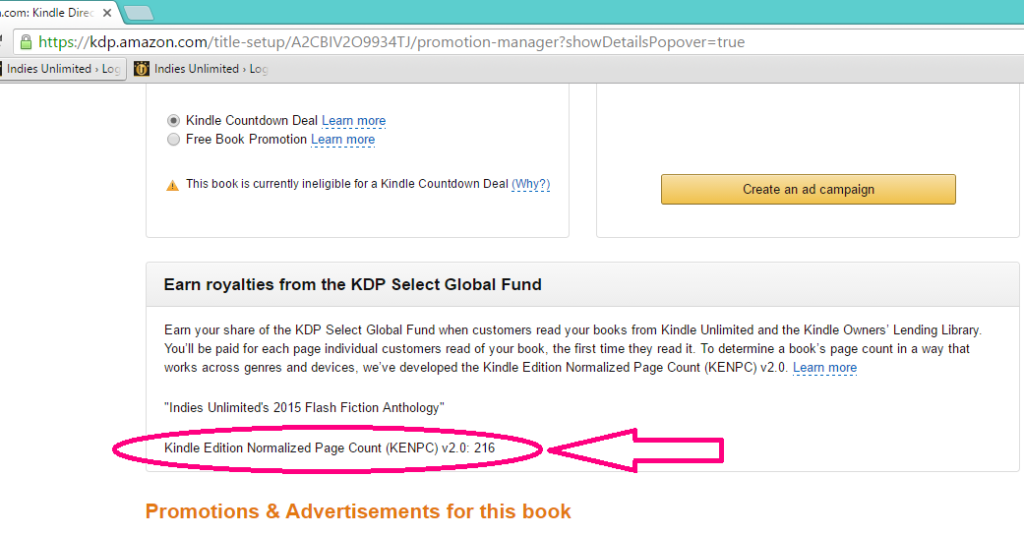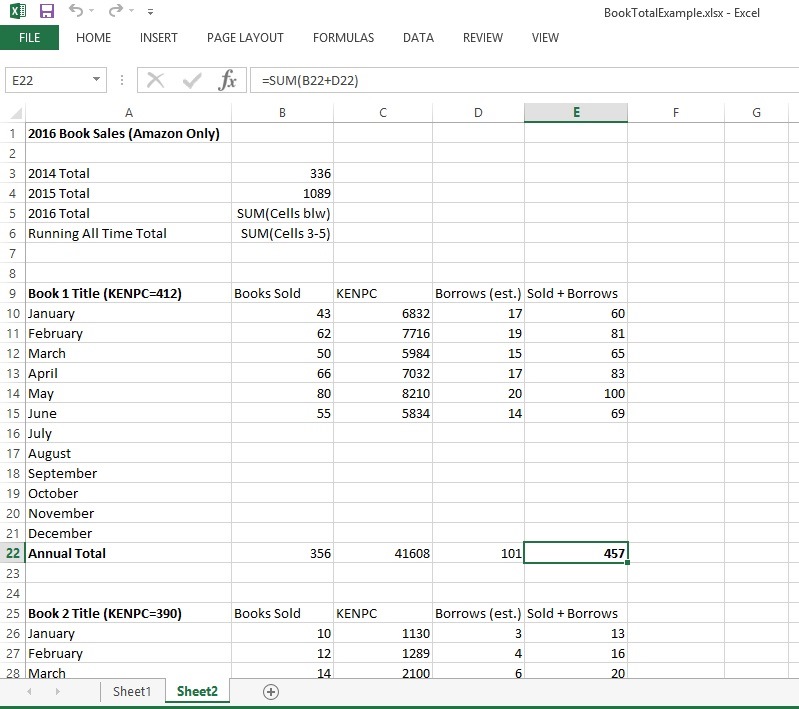 Do you ever get that question, “How many books have you sold?” Do you know the answer to the question? Well, today we’re going to talk about why you might want to know this number and the best way to keep track of books sold.
Do you ever get that question, “How many books have you sold?” Do you know the answer to the question? Well, today we’re going to talk about why you might want to know this number and the best way to keep track of books sold.
If you’re not keeping track, let’s start with the why you might want to. The most important reason is it helps you keep track of all your sales data on both a micro and macro level. If you find out the total number of books sold, it means you’ve been keeping track of the total number of each book sold. This individual book data can be helpful in both your marketing and writing strategies. If you presume your Christmas story will sell well in December, you may pour marketing into it blindly. But, a look at the number of book sales from your previous December may show that a different book is actually the high-performer at Christmas time. Also, as you record sales data, you can use it to figure out your series read-through rate. If you get 70 buys of book one in a series, and only 15 buys of book 2, that’s an indication that readers aren’t following through. So, you may choose to try rewriting book one, or you may just end the series. If you’re tracking your book sales, you can look for trends and patterns that can help you make decisions about your book’s success. As you publish more books, you can determine which ones or which series perform the best. And it’s also kinda cool to look at your stats and say, I’ve sold a thousand books (or 10,000, or 100,000 or more).
So, once you’ve decided you want to know how many books you’ve sold, what’s the best way to keep track of that information? A simple spreadsheet that tracks the sales monthly for each calendar year is going to be the easiest and make the most sense. This is because most sales data (for self-published authors) is offered monthly. The exact parameters of the spreadsheet you create will depend on whether your books are sold “wide” (multiple distributors) or solely on Amazon via Amazon’s KDP Select Program.
If your books are wide, your spreadsheet should look similar to this example (all the numbers in the spreadsheet are made up).

So, essentially, your spreadsheet will cover one calendar year, and you can post previous year totals near the top of your spreadsheet. For your current year, you’ll want to list the book title in the first column, and beneath that, list each month, January through December. In the rows beside the book’s name, list each vendor: Amazon, Apple, Barnes & Noble, Kobo, etc. As you get monthly data for each vendor, fill it in. You can sum the data across the rows, so you can see the monthly totals, and summing at the bottom of each column will give you the annual total for the books. If you have multiple books, scroll down a couple of cells and do the same thing for each of those books. To get the complete number of books sold that year, sum all your books’ annual sales once you have December numbers.
If your books are in Amazon’s KDP Select program, that means your books are likely receiving borrows as well as sales. The borrows are recorded in pages read. Because of this, you need to decide if you want to leave that information as is, or convert it. Simply leaving the number as it is means you’ll have one column that might say, 10 books sold, and next to it, 4,234 pages read. However, many people prefer to convert that pages read into a “minimum books sold” number. What is the minimum books sold? It’s the number of pages read divided by the Kindle Edition Normalized Page Count (KENPC) of your book. Amazon gives each book in Select a KENPC, and you can find it on your Dashboard when you look under KDP Select Info.  That will bring you to another screen where you can see I’ve circled the KENPC.
That will bring you to another screen where you can see I’ve circled the KENPC.  As an example, if your book’s KENPC is 400 pages, and you had 22,422 pages read one month, you would divide 22,422 by 400 and get 56.055. If we assume that everyone who borrowed it read all 400 pages of the book, at least 57 people borrowed your book (people can’t read more than 400 pages, so the .055 means someone borrowed it, but only read a few pages). Now, we know from that decimal that not everyone reads the entire book, so it’s possible that 4 people borrowed it and quit after 100 pages. Only, Amazon doesn’t give us enough information to figure out that kind of thing. That’s why 57 is the minimum number of borrows. It’s likely more people borrowed it and quit before finishing. But we know at least 57 people checked it out and started reading.
As an example, if your book’s KENPC is 400 pages, and you had 22,422 pages read one month, you would divide 22,422 by 400 and get 56.055. If we assume that everyone who borrowed it read all 400 pages of the book, at least 57 people borrowed your book (people can’t read more than 400 pages, so the .055 means someone borrowed it, but only read a few pages). Now, we know from that decimal that not everyone reads the entire book, so it’s possible that 4 people borrowed it and quit after 100 pages. Only, Amazon doesn’t give us enough information to figure out that kind of thing. That’s why 57 is the minimum number of borrows. It’s likely more people borrowed it and quit before finishing. But we know at least 57 people checked it out and started reading.
Because Kindle Unlimited minimum books sold is inaccurate, some people choose not to even try to convert pages read into sales. However, if you’re trying to get a “books sold” figure, this is the only way to convert pages read into sales data, even if it’s inexact.
For those in Select, you’ll want to set up the first column of the spreadsheet the same as the “wide” spreadsheet. However, when you go to the second column, instead of putting the vendor name, you’ll put “Books Sold” there. In the third Column, you’ll put “Pages Read.” If you choose to convert pages read to minimum books borrowed, your fourth column will be called Borrows. You’ll divide the total pages read for the month by the KENPC to get that borrows number. Here’s an example of what an Amazon KDP Select spreadsheet might look like (Again, I fabricated these numbers).  Now that you’ve got your spreadsheet set up, you just need to populate it with data. Most retailers offer monthly sales reports. It’s best to populate your spreadsheet once a month, after you’ve received all the reports. If you haven’t been keeping track, just use your previously downloaded monthly reports to backfill it. This will be time consuming, but going forward, it will be easy to do.
Now that you’ve got your spreadsheet set up, you just need to populate it with data. Most retailers offer monthly sales reports. It’s best to populate your spreadsheet once a month, after you’ve received all the reports. If you haven’t been keeping track, just use your previously downloaded monthly reports to backfill it. This will be time consuming, but going forward, it will be easy to do.
One last note, if you’re only selling on Amazon and new to publishing, you can use Get Book Report to track data. It’s a browser plugin that makes your Amazon data very easy to see, offering monthly totals for all books sold. However, Get Book Report is only available for Amazon (so, if you’re wide, you’ve got to track other data elsewhere) and it only pulls data for the last 90 days. So, unless you recently started publishing, it’s not going to give you accurate all-time sales numbers. Get Book Report is free for authors earning less than one thousand dollars per month, and $10 per month for those earning more than that.

Thank you, this is great. This has been on my to-do list forever, but somehow things involving math keep getting pushed down the list.
You’re welcome. Hopefully this will get it closer to the top of the ToDo list again. 🙂
This is something I have not been good about it; thanks for the kick in the butt. Now I’m curious. It should make for interesting reading!
Well, it’s always interesting when you see the numbers. I was surprised by which of my books sold best. I had an entirely wrong notion until I examined current numbers. So, hopefully it will be a help to you when you do it.
Well, RJ, you’ve certainly opened up a Pandora’s box. I’ve got about 7 years of data to look at! Holy cats, this is going to take a while, but what I’m seeing already is surprising me. Pleasantly! Thanks a bunch.
Doing my own taxes I have had to something pretty similar to this. I like how you simplified it. I think I over thought it and made it harder than it needed to be. lol Thank you for this post!
Tax season is always a kick in the butt to deal with numbers. It’s good you keep track yourself. I know a lot of people who rely solely on 1099s, with no way to check if the company issued form is correct or not. I’m glad this version was simplified enough. And this isn’t the only way to do it. I’m sure there are others who have ways that work well for them, too.
I currently have a main spreadsheet page with each title by year as well as the various formats (ebook, print, audio), then individual pages with sales each month. After reading this, I may combine all the sales by month for each book to get a better picture of what’s selling when. Thanks!
Your way sounds good, as well. I think there are a lot of good ways to do this. And my way didn’t account for the various formats, just ebook.
Thank you for all the valuable information. Until I read this article, I didn’t even know how to find the report in my book dashboard. I was just waiting to get a check without the slightest clue that I could see how much (or in my case, how little) royalties had been earned so far.
How much do we have to get to before Amazon will finally cut us a check?
Thanks again for sharing your knowledge.
Lance, I’m not sure the minimum threshold to receive a check. I imagine it’s fairly high ($100+) and I believe they charge you a fee to cut a check. Most people opt for electronic deposit (though I know this is not available in certain countries) because there’s no minimum. Each country pays separately, so I’ve gotten deposits for 35 cents due to a single sale in Japan (or another country that I normally don’t sell in).
If you’re not eligible for direct deposit, just keep track of any fees Amazon charges for issuing checks, so you can pull that off your earnings when you do your taxes.
Thanks for the info. Sales being meh, I never really bothered, but I might start one like yours this year.
Well, if you start doing it now, you can at least see where things are heading. I’m actually a little behind in my spreadsheet, but I use GetBookReport, too, for an easy peek at recent sales, and that gives interesting trends in an easy to read format.
Hi RJ,
Thank you for the nicely detailed article, it will definitely come in handy.
JB